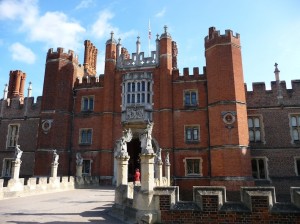I am currently reading All the King’s Cooks: The Tudor kitchens of King Henry VIII at Hampton Court Palace and loving all the wonderful details that Peter Brears has included about life at Henry’s court.
The term ‘bouche of court’ which meant ‘the right to receive food and other necessaries from the court’ (Pg. 12) was a privilege granted by the ‘White Sticks’. These officers, whose positions were held by the direct authority of the King, were represented by a white staff of office. It was their job to supervise the management of the household and inspect financial records, attempt to reduce wastage and determine the remuneration of the household staff.
Those entitled to ‘bouche of court’ were listed in an ‘ordinary’ – a document that listed exactly what each person should receive according to their rank (Pg. 12).
A duke, for example, received:
‘every of them for their Bouche of Court in the morning one chett lofe [brown loaf], one manchett [small white loaf], one gallon of ale; for the afternoon, one manchett, one gallon of ale; and after supper, one chet lofe, one manchet, one gallon of ale, one pitcher of wyne, and from the last day of October unto the first day of April, one torch, one pricket [candle], two sises [small candles], one pound of white lights, ten talshides [timbers for fuel], eight faggots and…from the last day of March unto the first day of November, to have moyety [half] of the said waxe, white lights, wood and coals, which doth amount in money by the year to the summe of £39 13s 4d.’ (Pg. 12)
An ordinary officer of the household received:
‘For their Bouche after supper, everie of them being lodged within the court, dim [half] chet lofe, dim’ gallon of ale; and from the last day of October unto the first day of Aprill, by the day, two sises, one pound white lights, two talhides, two faggots; and from the last day of March unto the first day of November, to have the moyety of the said waxe, white lights, wood and coals, amounting to the sum of £4 7s 5d.’ (Pg. 13)
The ordinary also specified those who were entitled to have both bouche of Court and their dinners and suppers, consumed either in the King’s Chamber, in the Queen’s side or with the remainder of the household and those who were only entitled to food and wages (Pg. 13).
This document went into minute detail about each individual’s menu specifying both content and cost. The King’s and Queen’s menu cost a whopping £3 5s 0d. daily, while that of a servant cost 2 ¼ d.
An ordinary of the 1540s revealed that the cost of feeding the entire court for one year was £16, 327 5s 5d! This is on food alone and does not take into account transport costs, fuel and equipment required to acquire and prepare the food, which was listed as costing an additional £4, 445 2s 6d.
The Tudor royal household was a complex organisation and one that I will be looking at in more detail over the coming weeks.


















No wonder they ran out of money and had to take over the monasteries–that’s a lot of stuff for a lot of people! And I think there was huge taking advantage and corruption. Wolsey tried to sort it out but I think it was ultimately a losing battle.